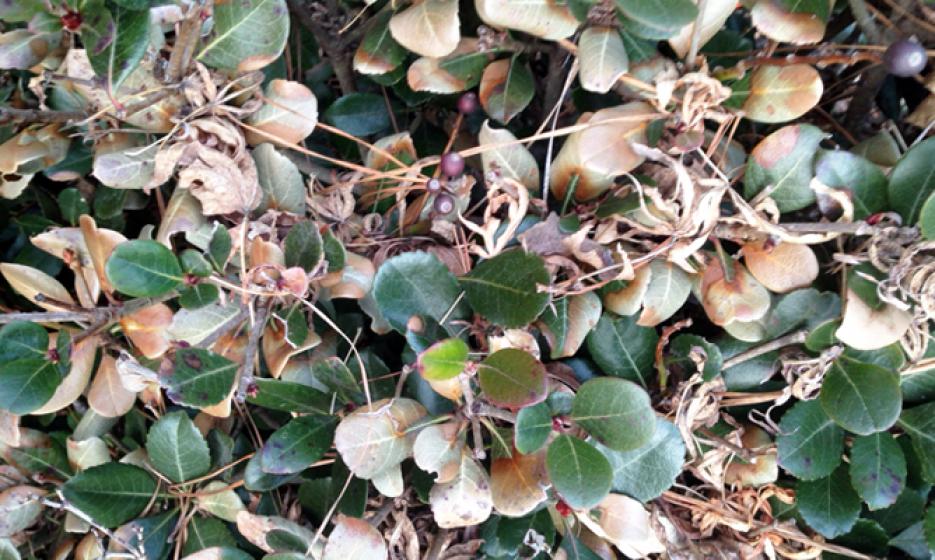This winter has been harsh and we've been getting lots of questions on what plants will have damage and what to do if they are. We've compiled all the best tips from our experts to help you identify your next step. Remember, you can always visit a McDonald Garden Center location and speak with an expert regarding your individual situation.
GENERAL TIPS FOR WINTER PLANT DAMAGE
- If you see damage, scratch the bark and look for green. Green means the plant is still alive.
- When trimming back, be sure to cut off any brown stems as the green is what's alive and that is where the new growth will come from.
- Broad-leaf evergreens tend to show the most damage. With low temperatures combined with wind drying the leaves out, these plants may show the most evidence of damage.
- Many plants that are normally evergreen or semi-evergreen either have leaf damage or dropped more leaves that normal. Examples include: Hellebore leaves might be brown but the plants are still alive and healthy and blooming. Abelia seems to have dropped more leaves than they normal would.
Gardeners should also remember, Hampton Roads experienced near record cold temperatures this winter. The good news is that we did have a cool down period as compared to an extreme temperature drop - this did give plants some time to acclimate to cooler temperatures.
COMMON PLANTS SUFFERING FROM COLD EXPOSURE
Oleander
Probably looks the worse for the wear. Most of the Oleanders on the Peninsula are brown, but there is a good chance they will come back from the root. You should cut them back hard to the ground to remove all of the damaged stems and leaves.
Fatsia
Fatsia is another plant that may need to be cut back to the ground, but should recover.
Gardenias
These are a mixed bag as there are now so many new types out there, so this one plant will depend on the variety and where it is sited as to what needs to be done. Some will need pruning and some will need replacing. There are some Gardenias such as 'Kleims Hardy', which is reportedly hardy to zone 6, which may have fared better but the flower is more like a daisy than a traditional gardenia, so we tend not to inventory that variety as often.
Tinus Viburnum
This year is the perfect year to show why this plant is not a good choice for our area. It tends to show leaf burn almost every year. We must just be sited in the wrong area for it. We warm up a little too soon and end up burning off the flowers and bronzing the leaves. We recommend using Indian Hawthornes as a replacement for this shrub.
Loropetalum
The damage seen here seems to be a matter of location - those with some protection did better than those in exposed sites and those that are established seem to be okay. In most cases, I think these will be fine with a light shearing to shape them. Most of what we've seen is green bark and this cousin to Witch Hazel looks like recovery should be good, again, not in all cases, ones planted last fall in very exposed sites may have more damage.
Indian Hawthorne
This will vary greatly from no damage to completely brown. In this case, we think its more varietal than location. We grow 'Eleanor Tabor', 'Snowcap' and 'Georgia Petite', they are all in beds within 100 feet of each other, 'Snowcap' has essentially no damage and looks the best, 'Eleanor Tabor' has some cold damage, and 'Georgia Petite' has cold damage on greater than 50% of the plant. We believe it may recover from the cold damage, but it may be a good time to remove them and try something new in their place. We have seen the same examples in several places, some that are totally brown, others that are fine, mostly they will need shearing to clean up. Our 'Georgia Petite' was notorious for leaf spot in late February/early March, so much so that almost all of the leaves would drop off and be replaced with new ones.
Encore Azaleas
These plants seem to have some cold damage, leaves defoliating and bronzing. We recommend a light trim and they will be fine, the bark looks good.
Palms
Palms are another area where we have seen some damage. Windmills seems to be fine, they are perfectly hardy, but others are showing up with damage, like large Sabal palms and European Fan palms. They are showing damage on the fronds though it's too early to tell. In many cases, we need to wait for warmer temperatures to know for sure how much damage there is and whether they will recover.

